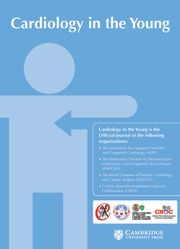Article contents
The utility of a structured, interactive cardiac anatomy teaching session for resident education
Published online by Cambridge University Press: 22 April 2022
Abstract
Paediatric residents are often taught cardiac anatomy with two-dimensional images of heart specimens, or via imaging such as echocardiography or computed tomography. This study aimed to determine if the use of a structured, interactive, teaching session using heart specimens with CHD would be effective in teaching the concepts of cardiac anatomy.
The interest amongst paediatric residents of a cardiac anatomy session using heart specimens was assessed initially by circulating a survey. Next, four major cardiac lesions were identified to be of interest: atrial septal defect, ventricular septal defect, tetralogy of Fallot, and transposition. A list of key structures and anatomic concepts for these lesions was developed, and appropriate specimens demonstrating these features were identified by a cardiac morphologist. A structured, interactive, teaching session was then held with the paediatric residents using the cardiac specimens. The same 10-question assessment was administered at the beginning and end of the session.
The initial survey demonstrated that all the paediatric residents had an interest in a cardiac anatomy teaching session. A total of 24 participated in the 2-hour session. The median pre-test score was 45%, compared to a median post-test score of 90% (p < 0.01). All paediatric residents who completed a post-session survey indicated that the session was a good use of educational time and contributed to increasing their knowledge base. They expressed great interest in future sessions.
A 2-hour hands-on cardiac anatomy teaching session using cardiac specimens can successfully highlight key anatomic concepts for paediatric residents.
Information
- Type
- Original Article
- Information
- Copyright
- © The Author(s), 2022. Published by Cambridge University Press
References
- 1
- Cited by


